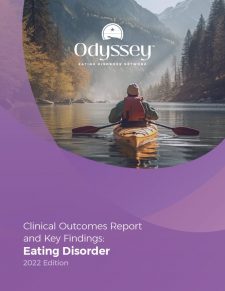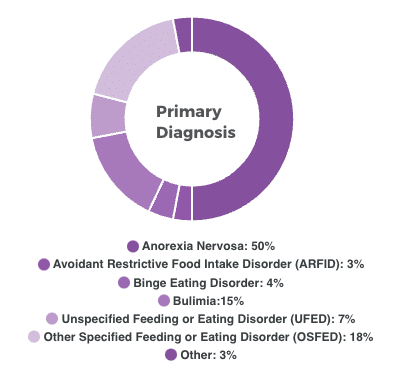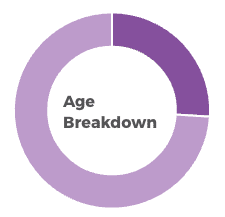2022 Clinical Outcomes and Key Findings
Home / Outcomes
About Magnolia Creek
As part of the Odyssey Behavioral Healthcare, Magnolia Creek offers evidence-based, quality care to adolescent and adult women, ages 12 and older, with an eating disorder and secondary co-occurring mental health or substance use disorder. Our goal is to provide comprehensive treatment to meet the psychological, medical, nutritional, spiritual, and relational needs of our clients.
Why Magnolia Creek?
Clinical Expertise
Our clinical experts provide evidence-based treatment, including nutrition therapy, for eating disorders and secondary co-occurring mental health or substance use disorders.
Fully Accredited
All levels of care are fully accredited by the Joint Commission, demonstrating our commitment to providing the highest levels of quality care.
Healing Environment
Expansive grounds and home-like environments set Magnolia Creek apart. The outdoors is a key component in the healing process.
Clinically Excellent Eating Disorder
Treatment Informed By Research
Behavior and Symptom Identification Scale (BASIS-24)
Magnolia Creek uses BASIS-24 to identify a wide range of symptoms across the diagnostic spectrum. Using a five-point Likert scale, the 24 questions are scored using a weighted average algorithm that gives an overall score and scores for six subscales that cover the following domains: depression, relationships, self-harm, emotional liability, psychosis, and substance abuse. The questionnaire was administered at admission, mid-treatment or every 30 days, and again at discharge.
Eating Attitudes Test (EAT-26)
Additionally, Magnolia Creek uses EAT-26, a leading standardized self-report measure of eating disorder symptoms and concerns. Using a six-point Likert scale in conjunction with additional measures assessing behavioral symptoms and body mass index (BMI), the assessment gives an overall score and scores for three subscales. The subscales cover the following domains: dieting which measures how much someone, motivated by a desire to be thinner, scrutinizes calorie content, carbohydrates, and sugar content, Bulimia and Food Preoccupation which assesses someone’s tendency to purge after meals and excessive food-related thinking, and Oral Control which identifies a person’s tendency toward needing less self-control over their eating.
EAT-26 Subscale Interpretation Guide
- Dieting – How much someone, motivated by a desire to be thinner, scrutinizes calorie content, carbohydrates, and sugar content.
- Bulimia and Food Preoccupation – Someone’s tendency to purge after meals and excessive food-related thinking.
- Oral Control – A person’s tendency toward needing less self-control over their eating.

Download a PDF Version of Odyssey’s Eating Disorder Residential Services Outcomes Report
2022 Client Demographics
511
Total Discharges
Primary Diagnosis
Age Breakdown
Primary Diagnosis

Age Breakdown

Teens: 26%
Adults: 74%
2022 Outcomes
Magnolia Creek’s Residential Services
At Magnolia Creek, we meet clients where they are in their recovery and provide the necessary therapeutic techniques to empower sustainable freedom. Our credentialed and experienced clinical teams help clients recover by creating individualized treatment plans consisting of various evidence-based treatment modalities.
2022 Clinical Outcomes (EAT-26)
Overall Reduction in Symptom Severity
0
%
Dieting
0
%
Bulimia and Food Preoccupation
0
%
Oral Control
0
%
2022 Clinical Outcomes (BASIS-24)
2022 Clinical Outcomes (BASIS-24)
2-Year Longitudinal Average (BASIS-24)
what our clients, their families, and clinical partners are saying
Magnolia Creek saved me, healed me, and guided me to FREEDOM! I just want to say to others with an eating disorder that there is hope. I had an eating disorder for 14 years and was terrified to go to treatment. Dr. H talked me into going after many calls and giving recovery a fair chance. When I finally got there, I had the best team (Maria, Jessica, and Leigh-Ann) work with me and push me because they saw my potential. I am forever grateful and am thinking about going to school for counseling or even possibly nutrition. We all deserve recovery and to be happy.
– Grateful Former Magnolia Creek Client
10/10 isn’t enough to qualify the treatment I received at the Creek, a positive atmosphere all day long and every person in the facility giving you support and good wishes. The counselors are the best you can find, and the staff members helped to solve any question I had. A great team of work which made my recovery possible.
– Grateful Former Magnolia Creek Client
Magnolia Creek is an exceptional treatment facility with knowledgeable and compassionate staff. My daughter has been fighting an eating disorder and other addictions for years and Magnolia Creek is the first facility that allowed for her to truly heal, change, and grow into the amazing young women that we knew she could be. Our family was included in treatment, and we were given the tools and education that we were lacking and taught the best ways to support our daughter in her recovery. The Admissions Team (Carolyn) was amazing, and the Clinical Director (Dr. C) was nothing short of a miracle for us. We have been so blessed to have found this wonderful facility and will be forever thankful for saving our daughter's life.
– Grateful Family Member of a Former Magnolia Creek Client
Thank you, Magnolia Creek! My daughter had another episode until she decided to get treatment. She is now stable thanks to the help and guidance obtained during her treatment. The staff is friendly, and Magnolia Creek has good amenities as well.
– Grateful Family Member of a Former Magnolia Creek Client
Magnolia Creek is a pleasure to work with and refer to. They are compassionate and understanding and eager to help in any way they can. Nothing but top-notch treatment and care for clients and their families.
– Clinical Partner of Magnolia Creek
I am an outpatient provider in the Birmingham community and Magnolia Creek is doing great work for those with eating disorders. Magnolia Creek is committed to providing outstanding care and are following appropriate COVID-19 protocols during this time.
– Clinical Partner of Magnolia Creek
Previous
Next
Download the PDF Version of Odyssey’s Eating Disorder Residential Services Outcomes Report
If you’d like to learn more about our eating disorder treatment programs, our caring staff is ready to help you. Call us or fill out the form to get started today.
100% Confidential